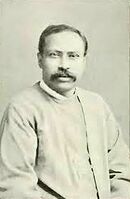Das, Sarat: Difference between revisions
No edit summary |
No edit summary |
||
| Line 3: | Line 3: | ||
|HasLibPage=Yes | |HasLibPage=Yes | ||
|pagename=Das, Sarat | |pagename=Das, Sarat | ||
|PersonType=Authors of | |PersonType=Authors of English Works; Authors of Sanskrit Works; Translators | ||
|images=File:Das Sarat Chandra Wikipedia.jpg | |images=File:Das Sarat Chandra Wikipedia.jpg | ||
|MainNamePhon=Sarat Chandra Das | |||
|namefirst=Sarat | |||
|namemiddle=Chandra | |||
|namelast=Das | |||
|IsInGyatsa=No | |IsInGyatsa=No | ||
|classification=People | |classification=People | ||
Revision as of 14:02, 20 January 2021
| PersonType | Category:Authors of English Works Category:Authors of Sanskrit Works Category:Translators |
|---|---|
| FirstName / namefirst | Sarat |
| LastName / namelast | Das |
| namemiddle | Chandra |
| MainNamePhon | Sarat Chandra Das |
| IsInGyatsa | No |
| Other wikis |
If the page does not yet exist on the remote wiki, you can paste the tag |
Full Name
Sarat Chandra Das
Affiliation
Education
Other Information
Born in Chittagong, eastern Bengal to a Hindu family, Sarat Chandra Das attended Presidency College, Kolkata|Presidency College in Calcutta.In 1874 he was appointed headmaster of the Bhutia Boarding School at Darjeeling. In 1878, a Tibetan teacher, Lama Ugyen-gyatso arranged a passport for Sarat Chandra to go the monastery at Tashilhunpo. In June, 1879, Das and Ugyen-gyatso left Darjeeling for the first of two journeys to Tibet. They remained in Tibet for six months, returning to Darjeeling with a large collection of Tibetan and Sanskrit texts which would become the basis for his later scholarship. Sarat Chandra spent 1880 in Darjeeling pouring over the information he had obtained. In November 1881, Sarat Chandra and Ugyen-gyatso returned to Tibet for where they explored the Yarlung valley, returning to India in January 1883 (Ref: Journey to Lhasa and Central Tibet, Das, Sarat Chadra, pp xi - xiii, Paljor Publications, New Delhi, 2001)
For a time, he worked as a spy for the British, going on expeditions into Tibet to gather information on the Tibetans, Russians and Chinese. After he left Tibet, the reasons for his visit were discovered and many of the Tibetans who had befriended him suffered severe reprisals. For the latter part of his life, Das settled in Darjeeling. He named his house "Lhasa Villa" and played host to many notable guests including Sir Charles Alfred Bell and Ekai Kawaguchi. Johnson stated that, in 1882 Das met with Helena Blavatsky and Henry Steel Olcott, the two individuals notable for the founding of the Theosophy Society.
Source (Accessed May 31, 2012)

